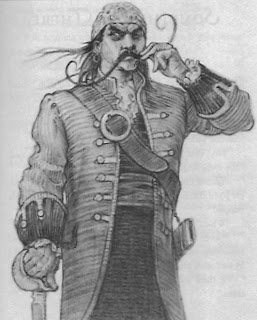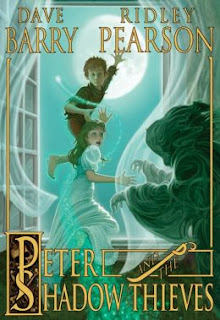One of the most evocative images from Peter Pan is Mrs. Darling's unattainable kiss.
Her romantic mind was like the tiny boxes, one within the other, that come from the puzzling East, however many you discover there is always one more; and her sweet mocking mouth had one kiss on it that Wendy could never get, though there it was, perfectly conspicuous in the right-hand-corner.
The beauty of the kiss as a metaphor is how many meanings it can encompass, and how much truth each of them can contain: Her innermost self, her remembered youth, her ability to live in more than one world at a time. I always took it as her longing for magic, a longing fulfilled when she meets Peter Pan face to face. He takes the kiss with him when he leaves the nursery that night, and she is left content in the knowledge that magic is indeed real, as she has always suspected and hoped.
But another meaning of the kiss has presented itself to me upon my repeated readings of the text, one drawn directly from James Matthew's own life, and mine as well.
 |
| Alice Woodward, 1907 |
Barrie's childhood was changed when he was six by the death of his fourteen-year-old brother David in a skating accident. His mother was disconsolate and never fully recovered from the tragedy, and young James sought to comfort his mother in any way he could, including pretending to be David in successful efforts to make Margaret Ogilvy smile. No doubt he felt the strain of being a replacement child, as this is a role that can never be fully successful. I have an understanding of this as I too am a replacement child, born four years after the death of the toddler who would have been my sister. Barrie recalled playing underneath the table that held David's coffin, and one of my earliest memories is of being taken to put yellow chrysanthemums from our garden on Elaine's grave. For fifty years her solemn face has looked down from a portrait on my parents' wall. I suspect her presence is not so different from that of David Barrie following his death.
Perhaps this explains the ambivalence shown by the narrator of Peter Pan for the characters of both Peter and Mrs. Darling. Consider that in an early draft of the play, Barrie planned to have one actress play both Mrs. Darling and Captain Hook. (Hook and Mr. Darling are traditionally performed by the same actor, bringing a world of new meanings to the narrative, but this came about when the actor hired to play Mr. Darling quit and Gerald DuMaurier asked to play the part in addition to his role as Hook.)
You see, the woman had no proper spirit. I had meant to say extraordinarily nice things about her, but I despise her, and not one of them will I say now. She does not really need to be told to have things ready, for they are ready. All the beds are aired, and she never leaves the house and observe, the window is open. For all the use we are to her, we might as well go back to the ship.
An apt description of the resentment and bitterness a son or daughter feels toward a mother who cannot let go of her departed child. Yet only paragraphs later, he recants, in an equally apt portrayal of the regret the child feels at having these emotions, and pity and love reassert themselves.
Now that we look at her closely and remember the gaiety of her in the old days, all gone now just because she has lost her babes, I find I won't be able to say nasty things about her after all. If she was too fond of her rubbishy children, she couldn't help it. Look at her in her chair, where she has fallen asleep. The corner of her mouth, where one looks first, is almost withered up. Her hand moves restlessly on her breast as if she had a pain there. Some like Peter best, and some Wendy, but I like her best.
 |
| Gwynedd M. Hudson, 1931 |
Barrie is ambivalent toward his ostensible hero as well. No harmless sprite in the book, Peter Pan is a self-absorbed child who kills pirates and steals children away with no thought for the damage he causes. This attitude on the author's part comes as no surprise to me. No matter how guilty one feels about it, it's hard to feel unconditional love for the child one replaces, the one who will always remain perfect and untouched and unchallenged by the world we live in. The replacement child cannot possibly hold the same place in a parent's heart, and coming to terms with this reality is a long and painful process, possibly one with no permanent resolution.
Mrs. Darling's own experiences with Peter Pan remain mysterious.
There were odd stories about him, as that when children died he went part of the way with them, so that they should not be frightened.
While she slept she had a dream. She dreamt that the Neverland had come too near and that a strange boy had broken through from it. He did not alarm her, for she thought she had seen him before in the faces of many women who have no children. Perhaps he is to be found in the faces of some mothers also.
 |
| Trina Shart Hyman, 1980 |
When she finally meets the boy, she recognizes him.
She started up with a cry, and saw the boy, and somehow she knew at once that he was Peter Pan. If you or I or Wendy had been there we should have seen that he was very like Mrs. Darling's kiss.
And when he leaves,
He took Mrs. Darling's kiss with him. The kiss that had been for no one else, Peter took quite easily. Funny. But she seemed satisfied.
In this way, Barrie restores comfort to her in a way he could not do for his own mother. Wendy could not take the kiss because it was not meant for her, or for her brothers or her father. Barrie's mother's kiss was saved for David, not little James Matthew, and my own mother's kiss is meant for Elaine, not for me.
Barrie said in a program note he wrote for the 1908 Parisian
production of Peter Pan: "[O]f Peter you must make what you will--perhaps he was a boy who died young and this is how the author perceives his subsequent adventures. Or perhaps he was a boy who was never born at all; a boy whom some people longed for but who never came--it may be that these people hear Peter more clearly at the window than children do."
 |
| Michael Hague, 1988 |
"O Nana, I dreamt my dear ones had come back."
Now that I've seen Mrs. Darling's kiss through this lens, I can't look away. What it shows me is too true to my own life, and it seems luminously stated throughout the book, if you know where to seek it. It is a clear-eyed look at a wrenching human experience--the death of a child--which marks indelibly more than those directly involved, leaving confusion and warring emotions in its wake.
Perhaps this is why the story has always resonated so deeply with me. Perhaps it's why I know how to look for Peter Pan, and why I also am skeptical of his charms.
















































